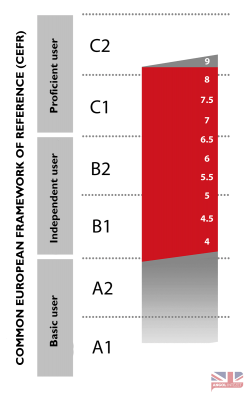CEFR stands for “Common European Framework of Reference for Languages” and is an international standard for describing language ability. It describes language proficiency on a six-level scale, from A1 for beginners, up to C2 for very proficient users of a language. This standard is not exclusive to English Language and can be used for any Language kind all over the world.
A leaner at the A1 level cannot communicate effectively, except for most basic information and isolated words or short formulated phrases in familiar situations. The communication skills of an A1 leaner are limited to most basic and simple needs, such as greeting or introduction.
A learner of B1 level is considered a modest user and has partial command of the language, and can cope with only overall meaning in most situations. A B1 user is likely to make many mistakes and can only handle basic communication, such as talking about likes and dislikes, daily life, reading simple texts, etc.
A C1 learner, on the other hand, is known as a good user and can communicate effectively in different situations. Also, they can talk about a range of topics, with some mistakes and inaccuracies, though. A leaner of this level can generally handle complex language and understand detailed reasoning. However, misunderstanding could take place in unfamiliar situations.
Two students of the same CEFR level may show differences in their skills. Completing a CEFR level is a long-term process. It can sometimes take several years for a learner to move from a CEFR level to a higher one. So, two learners of the same CEFR level can be at different stages of finishing that level, thus, showing different communication abilities. In addition, The higher learners get on the scale, the hard it becomes for them to make further development. For instance, it takes less than a year for an adult learner to finish the A1 level and become an A2 user. However, completing B2 level and becoming a C1 learner often takes 2-3 years. The task for a C1 learner to become C2 is even more challenging and usually takes more time than that.
We can establish a relationship between IELTS band scores and the CEFR scale. The diagram shows that each CEFR level includes two or three different band scores. So, a learner of C1 level, for example, might receive a band 7 or a band 8 in the IELTS test.
It may not be enough for IELTS candidates to know what CEFR level they belong to. Many people sit the test in the hope of scoring 6.5 or higher. According to the table, to ensure a band 6.5, the participant needs to be at the final stages of completing the B2 level. In contrast, an average B2 learner will likely get a band 6 on the test.
The higher learners climb up this ladder, the harder making further improvement becomes. Many students tend to give up learning a language at the B2 level, as this level, according to my experience, is the most challenging one. Since there is usually no rapid improvement in proficiency at this level, many lose their motivation and quit learning. Likewise, many IELTS candidates struggle to improve their Reading and Listening band scores from 6 to 6.5. The same applies to the other two skills, namely, speaking and writing.
[fvplayer id=”1″]


